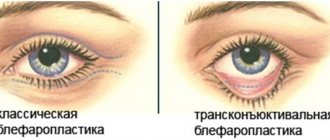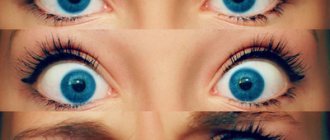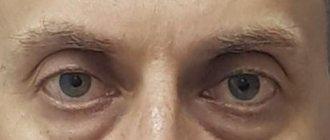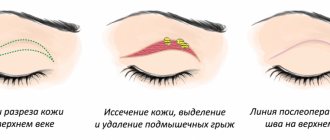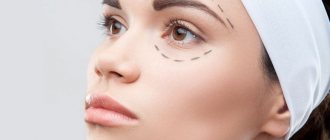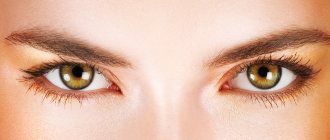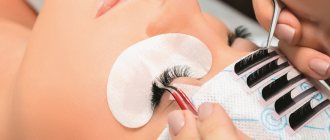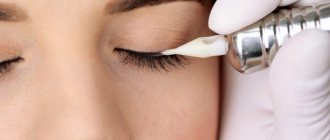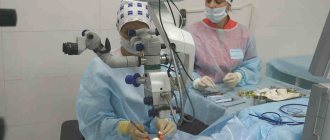Types of eyelid surgery
Traditional upper eyelid blepharoplasty
Traditional upper eyelid surgery is a plastic surgery that corrects the upper eyelids, removing eyelid hernias and fat bags by making an external incision and excision of excess eyelid skin. As a result of this operation, the seams will be barely noticeable and easily masked with concealer.
Traditional lower eyelid blepharoplasty
Traditional lower eyelid surgery is a plastic surgery during which the lower eyelids are corrected through an incision on the outside at a distance of 2-3 mm from the ciliary edge, through which fatty tissue is removed. As a result of this operation, a barely noticeable scar is formed.
Transconjunctival blepharoplasty
Transconjunctival eyelid surgery is a plastic surgery in which an incision is made on the inside of the eyelids, through which excess fatty tissue is removed and the outer corners of the eyes are corrected. As a result of this operation, there are no visible seams.
Circular blepharoplasty
Circumferential eyelid surgery is a plastic surgery that involves simultaneous correction of the upper and lower eyelids. As a result, a whole range of problems are solved, such as: sagging upper eyelids, swelling, bags under the eyes, asymmetry of the palpebral fissures and wrinkles around the eyes.
Laser or non-surgical blepharoplasty
Laser or non-surgical eyelid surgery is an operation that is performed using a laser on the skin of the eyelids. As a result, dark circles under the eyes, folds, bags and wrinkles around the eyes disappear.
Singapura or ethnic blepharoplasty
Singapori or ethnic eyelid surgery is a plastic surgery aimed at transforming Asian eyelids into European ones. As a result, the shape of the eyes changes, the epicanthus is removed and a fold is formed on the upper eyelid.
Canthopexy
Canthopexy is a plastic surgery whose purpose is to lift the outer corners of the eyes. As a result, the effect of bulging eyes, which could be caused by various diseases or be a congenital feature of a person, is eliminated;
Fat-saving or fat-sparing blepharoplasty
Fat-saving or fat-preserving eyelid surgery is a plastic surgery during which excess fatty tissue in the eye area is not removed, but is redistributed, thereby minimizing the number of wrinkles in this area.
1
/
What it is
The skin in the periorbital area is very thin, so it undergoes pronounced age-related deformations: it loses turgor and becomes covered with a network of fine wrinkles. The fat layer becomes denser over the years, creating the effect of an impending eyelid. As a result, a tired, “extinguished” look appears.
There is also a natural phenomenon characteristic of the Mongoloid race - the Asian shape of the eyes - the absence of a supraorbital fold, due to which the eyelids also appear swollen.
Such aesthetic problems can be solved with blepharoplasty. During the operation, the epicanthus is removed - that part of the skin that covers the inner corner of the eye.
The procedure is carried out in a clinic. It is suitable for both women and men.
Efficiency
The essence of upper eyelid blepharoplasty is that the surgeon makes an incision in the correction area using a scalpel and removes fatty tissue and hernia.
Additionally, part of the skin may be removed. The procedure is characterized by a long period of preservation of the effect - at least up to 7 years.
When performing the operation using the laser method, the period is slightly reduced - up to 5 years. But in this case there are no scars or scars left.
Indications for use
- Drooping corners of the eyes;
- Stretching of the skin;
- Subcutaneous neoplasms in the form of fatty hernias;
- Presence of epicanthus;
- Pronounced wrinkles;
- Congenital drooping of the eyelid, which makes applying decorative cosmetics uncomfortable;
- Weakening of muscles;
- Sunken eye sockets;
- Deep nasolacrimal grooves.
The procedure can also be prescribed as prescribed by an ophthalmologist in case of subcutaneous hernia formation or vision impairment.
Indications for use
- Bags under the eyes;
- Drooping upper eyelid;
- Drooping of the outer corner of the eye;
- Bug-eyed;
- Deep nasolacrimal groove;
- Injuries of the century;
- Benign formations in the eyelid area;
- Congenital or acquired eyelid defects;
- Wrinkles on the eyelids of various localizations;
- Excess skin on the upper or lower eyelids;
- Fat bags in the upper or lower eyelid;
- Hernias of the eyelids.
Method of operation
Even if the shape of the eyelids needs correction not because of age, but because of congenital or acquired defects. Or, if necessary, correction of the Asian eyelid and removal of the epicanthus. Thanks to blepharoplasty, you can get rid of the drooping upper eyelid, which creates the effect of a heavy, tired look, or raise the outer corners of the eyes, which can significantly affect the overall appearance of the eyes. Sometimes, the reason for the need for plastic surgery can be women's anxiety that they cannot apply decorative cosmetics the way they would like. The main thing is that when changing the shape of the eyelids, the plastic surgeon takes into account the individual characteristics of the patient’s face. Therefore, the doctor strives for a result that will ultimately look harmonious.
Before deciding to carry out such an operation, you should consult with a specialist who will help identify the presence of contraindications by prescribing the patient to undergo a number of tests, such as: general blood and urine analysis, biochemical blood test, blood for HIV and hepatitis, syphilis, coagulogram, as well as ECG and fluorography. You should definitely consult with an anesthesiologist if general anesthesia will be performed during the operation. After specialists have carefully studied all the test results, a date for blepharoplasty is set. It is recommended that you stop taking medications that thin your blood a few days before surgery, and also not drink alcohol or smoke cigarettes. The last meal before surgery must be taken at least 8 hours before. It would be a good idea to purchase eye drops and ointments in advance on your doctor’s recommendation. After the preparatory stage, the patient arrives on the appointed day at the clinic, where he is given a place in the hospital. There he can change clothes before the operation and wait for the start. When all specialists are ready, the patient is invited to the operating room. The patient's eyelid skin must be cleaned of impurities and treated with an antiseptic. For convenience, the plastic surgeon marks the eyelids with a marker. After this, local or general anesthesia is administered. When the painkillers begin to take effect, the plastic surgeon begins to perform eyelid surgery. The scheme according to which the operation will be performed depends on the type of blepharoplasty. But usually the incision begins first on the upper eyelid using a scalpel or laser, and only after that other incisions or excision of excess eyelid skin are made. When the necessary manipulations with the eyelids are completed, sutures are applied or the wound is sealed with a laser. The eyes are then covered with a bandage and a cold compress of ice or chilled gel pads. The patient is then sent to a hospital room, where he stays from two hours to a day. The total time of the operation directly depends on its complexity and can range from 30 minutes to two hours. The patient can open his eyes immediately after the eyelid surgery is completed. After two days, you will need to come to the clinic to remove the sutures, if self-absorbing threads or a laser were not used. If necessary, the doctor prescribes painkillers to facilitate the rehabilitation period.
Blepharoplasty results
Immediately after the operation, the result is difficult to assess, because there is swelling and hematomas. It is recommended to carefully follow all instructions given by the doctor, namely, use eye drops and ointments. It would not be a bad idea to do eye exercises, which promote the drainage of lymph and accelerated healing of wounds after surgery. If the patient experiences pain during the recovery period, he can take pain medications prescribed by his doctor. 2-3 weeks after blepharoplasty, the swelling begins to subside and then the result of the plastic surgery appears. After one and a half to two months, the scar after eyelid surgery becomes less noticeable, and then it will be possible to evaluate the result obtained. But a scar is formed if the incision is made with a scalpel from the outside of the eyelid. When transconjunctival or laser blepharoplasty is performed, no scar is formed at all, which is a big plus. After completing the rehabilitation period, wrinkles around the eyes will smooth out, bags under the eyes and hernias of the eyelids will disappear. The drooping upper eyelid will become more taut, and the eye shape will become open. The impression of a heavy or tired look will disappear. Congenital or acquired eyelid defects are corrected. The effect obtained as a result of blepharoplasty lasts for a period of 10 to 20 years.
Circular blepharoplasty
Upper blepharoplasty and canthopexy
Methods for correcting drooping eyelids
There are several methods to get rid of an aesthetic defect. Which one is effective in each specific case depends mainly on the severity of the problem.
At the first signs of ptosis, special exercises that strengthen the orbicularis oculi muscle help. The visual effect will be supported by special makeup.
If the defect is mild, correction of a drooping eyelid without surgery is effective using Botox injections or botulinum toxin-based serum applications.
Plastic surgery can radically eliminate negative changes.
What should you avoid immediately after eyelid surgery?
- Application of decorative cosmetics;
- Use of contact lenses;
- Being outdoors without sunglasses;
- Sunbathing on the beach;
- Eye massage;
- Heavy physical activity and sports;
- Long reading on electronic media;
- Eye strain;
- Sleeping on your stomach;
- Working in an inclined position;
- Washing the eyes before removing the stitches;
- Visit to the swimming pool;
- Thermal treatments: sauna, steam bath and steam room.
Contraindications for carrying out
- Increased pressure inside the eyes;
- Presence of thyroid diseases;
- Impaired blood clotting;
- Asthma;
- Diabetes;
- Presence of hypertension and heart disease;
- Oncology;
- Sensitive skin prone to allergies;
- Presence of skin damage and diseases;
- Dry eyes;
- Disruption of the tear ducts and glands;
- Exacerbation of chronic diseases of internal organs;
- Conjunctivitis;
- Blepharospasm;
- Infectious diseases in the chronic stage
- Age less than 18 years;
- Menstruation.
Read more detailed information in the special section of our forum
Reviews on the forum
Reviews
Lyudmila, 54 years old
“There were bags under my eyes. At the appointment, the doctor showed me photographs of patients before and after surgery and asked me to take tests. Blepharoplasty was successful. In the mirror I saw severe swelling, bruising and some dried blood. After the operation there was pain in the area of the incisions. After 5 days, the stitches were removed, and the incision sites were pulled for about a week. But the doctor said it was normal. After 10 days I was allowed to use cosmetics carefully. After 25 days, my eyes returned to normal, I felt fresher and, of course, younger. Don't be afraid that your eyelids may swell. It’s only temporary, the result is worth it!”
09-06-2012
Elizaveta, 46 years old
“I have a classic problem - drooping upper eyelids. The surgeon prescribed an upper correction and explained that my problem was related to the structure of the eyes and low-set eyebrows. The operation was performed under general anesthesia. Afterwards I stayed in the ward until the next morning. I didn’t feel any discomfort. Of course, there were bruises and swelling around the eyes. At first, when I went outside, I put on glasses. The bruising went away in about 10 days, and the swelling went away after a month. I'm pleased with the result. The effect of tired eyes disappeared, I looked noticeably younger. Now it’s hard to guess my real age.”
09-06-2015
Polina, 49 years old
“There were hernias on the lower eyelids, and the upper ones were very drooping. I couldn't even apply eyelashes properly. The mascara remained completely on the upper eyelids, and the look behind the folds was very tired. The surgeon said that the sagging skin was due to a large amount of fat deposits. The operating period lasted 2.5 hours. I came back from anesthesia, had a bandage over my eyes, an hour later they gave me a mirror, I was pleased with the result, since the bruises and swelling were not as bad as I expected. I was advised to wash my face with caution and to come back for a check-up in three days. The stitches were removed on the 8th day. At first there was discomfort, but as the incisions healed, it disappeared. I'm amazed by the end result. Thanks to the surgeon who gave me a second youth.”
14-07-2013
Nadezhda, 30 years old
“I had surgery on my upper eyelids, since my lower eyelids are fine. The result is amazing, exactly what I have wanted since I was 13 years old! And most importantly, now I don’t feel the pressure of my eyelids on my eyes, it feels like my visibility has increased, new horizons have opened up! They used to give me 26 years, but now I look like I’m 20.”
25-09-2012
Anna, 40 years old
“I went for surgery because my eyelid had drooped over time. I had the upper classic blepharo done by Maxim Alexandrovich. The result has made me very happy all this time; I have never regretted my decision. Your face just transforms! Anyone who is thinking about what to do or not to do – definitely DO IT!!! Don’t even doubt it!”
05-02-2013
Tatyana, 38 years old
“A month has passed. It's all behind! And how many fears there were before having plastic surgery! There was no pain under local anesthesia, but I felt like they were cutting out excess tissue from the eyelid. This is the only unpleasant experience. A little over an hour later I left the operating room. I was warned that my eyes might swell, so I applied ice to my eyelids. No painkillers were required. The first week passed in anxiety and discomfort. But the effect exceeded expectations! Now I advise everyone not to be afraid of her.”
15-04-2015
Elena, 41 years old
“I had upper blepharoplasty - the surgeon removed the skin of the upper eyelids hanging over my eyes. She agreed to general anesthesia. After the operation, I was given a room, and the next day I put on dark glasses and returned home. By evening, a bruise appeared around each eye, and there was a feeling of tightness when blinking. Within a week, I took the risk of putting makeup on my eyelids; the medicinal cosmetics reliably hid the stitches. After 3 months, I look like I’ve dropped 5-8 years in age, now every eyelash is clearly visible. I wish I had decided to have surgery a long time ago!”
22-07-2015
Alexandra, 50 years old
“I have long been tormented by the problem of bags under my eyes, and my upper eyelids began to droop heavily, giving my face a gloomy, sad expression. Before the operation, I took a blood test for group and coagulability. In both eyes, the lower fat bag was removed in about 2 hours and the upper eyelid was shortened along the natural crease. A laser device was used, so after the operation there was practically no blood coming out of the wounds. A bandage was secured to each suture and the sutures were removed on the third day. When the swelling subsided, the face became younger and more attractive. The cosmetologist asked me to prescribe a suitable mascara that would not irritate the seams. An old dream has been turned into reality by the hands of a doctor!”
15-07-2016
More
Surgical correction of ptosis of the upper eyelid
Surgery to correct upper eyelid ptosis can be performed in conjunction with blepharoplasty. This type of correction of drooping upper eyelid is a plastic surgery on the upper eyelids, during which not only the appearance of the eyelids improves, but also age-related changes around the eyes are eliminated. During surgery to correct congenital ptosis of the upper eyelid, a small strip of skin is removed and the orbital septum is cut. Then the muscle that lifts the upper eyelid is carefully isolated, and the specialist places several sutures on it to shorten it. After which the wound is sutured with a continuous cosmetic suture. In cases of severe congenital ptosis of the eyelids, the muscle is sutured to the frontal muscle. After correcting the drooping of the upper eyelid, a bandage is applied to the eyes, which the patient can remove after a couple of hours. Typically, after surgery, the patient does not experience pain, but swelling and bruising may appear, disappearing within a week. The stitches around the eyes are removed on the fifth day. This operation takes at least two hours and can be performed under either local anesthesia or general anesthesia.
Question answer
What do you use to fill the hollows under your eyes, Rusif Bezhanovich?
Based on practice, your own fat is injected under the skin of the eyelids, i.e. lipofilling is performed. If the infraorbital recesses are large and the patient has no contraindications, then infraorbital implants are placed. As a rule, this issue is resolved during a preliminary consultation.
Is eyelid surgery performed for myopia?
Yes, blepharoplasty is performed provided that the disease is not in the acute stage. However, you need to consult an ophthalmologist and make sure that there are no contraindications. Wearing glasses is possible after a couple of days of rehabilitation.
How long does it take for stitches to be removed? Will there be scars after them?
Depending on the course of the rehabilitation process, the sutures are removed within 3-5 days. Scarring of the skin in the eyelid area is not recorded, since with the upper type of plastic surgery the incision is made along the natural fold of the skin, and with the lower type - under the eyelash line.
How long will the effect last?
As a rule, the results of plastic surgery are visible within 5-15 years. In each case it is individual.
What are the advantages over other non-surgical correction methods?
Non-surgical methods include cosmetic creams with a lifting effect and physiotherapy using hardware facial cosmetology methods. A significant disadvantage of external correction methods is that the effect is visible only at the initial stage of blepharoptosis. The advantage of the operation is that at any stage of development of ptosis there is the possibility of its correction.
How is the operation performed?
For the operation to proceed well, a number of conditions must be met at the preparatory stage.
If the recommendations are not followed, negative consequences may occur, which will be more difficult to correct with repeated surgery.
Preparation
Two weeks before the procedure, reduce smoking and stop drinking alcohol.
Avoid taking medications whose composition may cause changes in blood counts.
Eliminate sweet and flour products from the diet, as well as salty and spicy foods. The latter actively retain moisture in the intercellular space, as a result of which the operated patient experiences high-grade edema.
Stages
- Clean and dry skin is disinfected with an antiseptic, then markings are applied with a special marker (incisions will be made along the contours).
- Anesthesia is administered. The type of anesthesia depends on the individual characteristics of the patient, the scale of the operation, the condition of the periocular muscles and predisposition to an allergic reaction to the drug.
- Excision of the skin and its subsequent transformation. Additionally, they eliminate excess fatty tissue and hernias, and tone muscles and ligaments.
- Apply sutures and an antiseptic patch or sterile bandage to the affected area.
On average, a session lasts from 30 minutes to 2 hours, depending on the complexity of the procedure and the experience of the specialist.
Plastic surgeons and clinics specializing in Blepharoplasty surgery:
Mamedov Rusif Plastic surgeon
Specialization
- Mammoplasty
- Rhinoplasty
- Facial plastic surgery
Sergey Demin Plastic surgeon
Specialization
- Mammoplasty
- Abdominoplasty
- Lipofilling
- Liposuction
Farhat Fuad Plastic surgeon
Specialization
- Mammoplasty
- Abdominoplasty
- Cruroplasty
- Liposuction
Comments and questions
Marina 10.20.2017 at 10:14 am # Reply
I’ve had these hated bags under my eyes all my life since college, and then it got worse, at the age of 30 I finally decided to have surgery and now 6 months have passed! I’m very happy, finally I can stop feeling complex and live life to the fullest! The operation and rehabilitation were very successful, thanks to your doctors for their golden hands!
What are the types of blepharoplasty?
Types of blepharoplasty are determined by the area of operation. Blepharoplasty of the lower eyelids is considered one of the most difficult. The surgeon makes an incision along the eyelash line on the inside of the eyelid. This method is indicated if the task is to eliminate deep wrinkles or excess tissue. Most often, surgeons work with the upper eyelid. After the operation, the patient gets rid of the discomfort caused by sagging skin. This method is effective in cases where the need to change the size of the eyes is determined. The surgeon makes an incision in the palpebral area of the eyelid fold. As a result, after the operation, the skin visually appears more toned and the effect of fatigue disappears.
Circular plastic surgery involves excision of both the upper and lower eyelids. It allows you to get rid of wrinkles and fat bags. Particularly effective when you want to lift the corners of your eyes. Most often, this operation is performed to eliminate signs of age. There is also a seamless method of surgical intervention - transconjunctival blepharoplasty. The doctor uses special instruments to penetrate the conjunctiva. The skin of the eyelid is not injured. Vision does not deteriorate, despite the seemingly dangerous proximity to the eye in which the doctor works. This method is considered gentle and does not require long-term rehabilitation - the patient recovers in just a week. The manipulations are almost painless. However, if the skin of the lower eyelids is very sagging, transconjunctival blepharoplasty will not be effective. In this case, the procedure is carried out using other methods, depending on the indications: using a scalpel or laser.
In pursuit of fashion, Asians who want to become like Europeans resort to Singapore. This operation helps to lift the corners of the eyes. The most gentle method of laser eyelid correction is laser blepharoplasty. It is used when the patient wants to remove excess skin, correct drooping eyelids, get rid of bags under the eyes and age-related deformities. This operation is less traumatic. After it is carried out, the risks of bruising, scars and hematomas are minimized.
